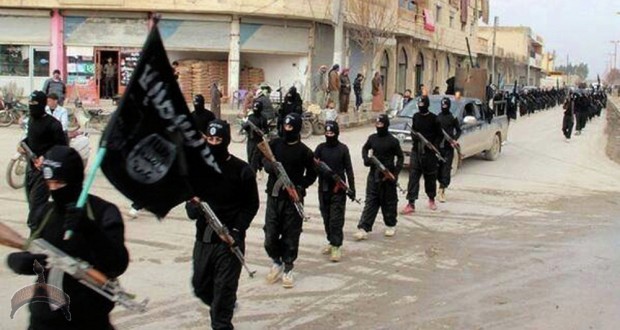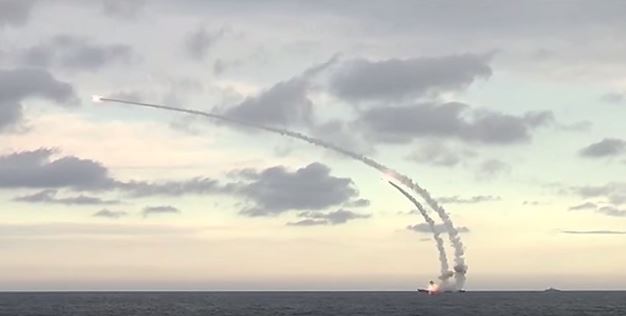By Aram Mirzaei
Since the start of this year, with the Russian brokered “de-escalation” zones imposed on several areas in Syria where Washington’s “moderate” rebel proxies are operating, virtually all other forces in Syria have committed themselves to engaging the self-declared Islamic State.
With these developments, it did not take long for ISIL to feel the effects of this change in priorities. Starting from January/February, the Syrian government forces and its allies have liberated swathes of land from the terrorist group. By early April, ISIL had been kicked out of the Aleppo province while the Syrian Army continued to open multiple new fronts all over central Syria. By early August this year, ISIL had been almost kicked out of the Raqqa, Homs and Damascus provinces as a result of the Syrian Army’s massive push towards the besieged city of Deir Ezzor.
In the meantime, the US backed “moderate” proxies in Idlib and Western Aleppo have been forced to stand idly by as the Syrian Army expands its control over the country. This is a result of Russian diplomacy at its best. Attempts have been made before to reach such lasting ceasefire deals, most notably the one last year between Russia and the Obama regime, it failed miserably after the US “accidentally” bombed Syrian Army troops fighting ISIL in Deir Ezzor.
So why did it work this time? I argue that the major reason for the success of this latest ceasefire is mainly due to Washington being excluded from the deal. When reflecting on previous attempts to establish a lasting ceasefire and the reasons for its failures, compared to this one that is seemingly more successful than its predecessors, its not hard to conclude that Washington, was and has always been the main obstacle for peace in Syria after almost 7 years of fighting and suffering.
Quite recently, Washington also announced it was ending its support for “moderate” rebels in Southern Syria, sparking hopes among some naive observers that the proxy conflict might be coming to an end. These observers however fail to understand Washington’s commitment and dedication to assume control of a situation that has been slipping out of their hands ever since Russia officially entered the conflict in 2015. What they also fail to understand is that Washington did not just abandon its plans for Syria, indeed it is likely that they will have to abandon their illegal base in the Al-Tanf border region in Southern Syria, but that does not mean the end of Washington’s involvement in the conflict, because that would require Washington to admit to defeat, which they hardly are capable of doing.
Instead, Washington is preparing its next move, and it will make use of another long-standing proxy force of theirs- the SDF. The Kurdish-led militia has assumed a larger role as the conflict has been dragging on, with SDF forces occupying large parts of northern Syria after wrestling control of these areas from ISIL. The SDF has since its formation in 2015, acted as the main proxy force fighting for Washington’s interests under the guise of creating a “federative direct democratic union” in northern Syria, also known as Rojava, despite fierce protests from Washington’s NATO ally Turkey.
What is the Rojava?
Kurdish domination in Rojava, on the edge of the violent dissolution of the Syrian state, is hidden behind a thick ideological smokescreen from the good consciences of Western lefties. This area under the control of the nationalists of the PKK from Turkey casually intone the siren songs of ecology, feminism and participatory direct democracy. It’s a music relayed and amplified by all kinds of leftists and by the subsidiaries, established in developed countries, of the cult of adoration of Öcalan, the founder of the PKK imprisoned for more than fifteen years on the island of Imrali. So the claim made by these lefties, one that is confirmed by the Kurdish-led PYD party, is that the Rojava project opposes all kinds of imperialism.
In addition to scoring massive sympathy points among ignorant people in the West, this portrayal of Rojava as “anti-imperialist” and leftist has attracted different far-left violent extremist groups such as Antifa and other anarchists. These groups, often deemed as extremists and even terrorists in their own countries, travel from all over the world with their own agenda, under the guise of being part of an ”International freedom battalion” that fights fascism.
Yet this claim cannot reconcile with the fact that ironically enough, Rojava remains one of Washington’s closest allies in Syria, nor can it reconcile with the fact that these foreign leftists who have traveled to Syria “to fight imperialism and oppression” are playing the role of pawns in Washington’s so called war on terror. As a matter of fact, SDF spokesman Talal Silo made it clear that the SDF does not make a single move until their masters in Washington say so.
You would think that this was already a tragic case, but for some reason these days, it always gets worse.
On July 24 the so called ”International Revolutionary People’s Guerrilla Forces” (IRPGF), a group of international fighters and volunteers fighting alongside the SDF announced on their Twitter page the creation of a “subgroup comprised of LGBT comrades and others who seek to smash the gender binary”.
The group calling itself TQILA, was to join the fight against ISIL according to an announcement on Twitter. This announcement was soon picked up by Western media outlets amid gleeful reactions by leftists, progressives and gay celebrities on their social media accounts. We learn, from the founding statements of TQILA and its umbrella group, IRPGF, that their causes of “anarchism”, “smashing gender binary”, and “sexual revolution” are all connected to the most selling hegemonic narrative of the 21st century: the “war on terror”.
Why anarchists would go to a country devastated by war and terrorism for years and spread anarchism is beyond any reasonable person. It is not only ridiculous, but it is also playing into Washington’s plan to sow discord and chaos in the country.
This romantic sketching of a revolutionary path to utopia in a conflict that has shown the world how ”revolutions” can destroy an entire society is nothing short of pathetic.
The Rojava administration in northern Syria, which was founded by the Democratic Union Party (PYD) – YPG’s political arm – in 2013, has been portrayed as a success story of the “struggle against borders and for autonomy” by the international media and self-identified leftists and progressives.
Others applaud “the Kurds” – a common synonym used by leftists to refer to PYD – as “the best hope for left politics in the region”. PYD is also presented as a big champion for “gender equality” as a result of its inclusion of women in its armed forces.
Nevertheless, the PYD, like the rest of the conflicting parties in the region, commits human rights violations, targets its dissidents, including peaceful protesters and forcibly evacuates Arab and Turkman civilians – and some Kurds – from their villages.
There are also those that point to “the Kurds” as deserving of their own territory, because of their fight against ISIL. The last time I checked, no land and territory has ever been “deserved” by any people and given to them as charity, but rather it was conquered. It is also ironic that the same “kurds” that claim Rojava to be a social revolution based on multiethnic co-existence, are the same ones that base their argument for Rojava’s existence on ethno nationalist grounds, citing the century long struggle for “kurdish independence”. Of course, proponents of the Rojava project always seem to be missing the fact that kurds make up less than 10 % of Syria’s population and that they occupy almost a third of the country.
To suggest that “gender and sexual revolutions” are being accomplished by joining a party that fights on behalf of Washington’s is a colonial rewriting of Syria’s struggle. According to these international extremists and their leftist supporters the struggle is ”to fight imperial and state power”, but for the Syrian people, their struggle is one about self-determination, something that the US, its allies and these ”progressive” leftist idi0ts have been trying to deprive them for years.
What does Washington want with Rojava?
Since most Western leaders seem to have accepted the reality that Syrian President Bashar Al-Assad is not going anywhere as long as Russia is standing by his side, there must be a new plan. If the regime change agenda in Syria, motivated by a desire to disrupt the Iran-Syria alliance and thereby protecting Israel has failed, then the second best thing next to regime change in Syria would be to isolate Syria from Iraq and Iran. This would be achieved by cutting the Syrian Army off from the Deir Ezzor province, thereby severing any land connection between Syria and Iraq. Interestingly, this is exactly what the US-backed forces, airlifted by the US from the Al-Tanf area to southern Hasakah, have been planning. But this shouldn’t come as news to anybody since Washington and its allies have been quite open with this idea since 2012 already.
Washington has been betting on many horses over the course of the Syrian war, but none of them have ever been as successful as the SDF. Earlier experiments with Syrian proxies yielded little and actually managed to damage Washington’s reputation somewhat, especially when the ”moderate rebels”, trained and armed by the CIA turned to Al-Qaeda the moment they crossed the border from Turkey where they had been trained, into Syria.
In the SDF however, Washington has found a reliable proxy, one that is not shy to offer the US to establish military bases across its territory, one that has garnered a good reputation among people in the West as the only representative of democracy in Syria, and one that is never going to say no to Washington’s biddings.
Despite Washington assuring Turkey that it will not allow “the Kurds” to declare independence and break away from Syria, Washington will not pass up this opportunity to gain a major foothold in what could be considered a Russian and Iranian “zone of influence”. Thus Washington will do everything in its power, including maintaining a permanent military presence in Syria, to try to balance a co-existence between Turkey and “Rojava”. Even SDF spokesman Silo said: “The Americans have strategic interests here after the end of Daesh,” using a pejorative term for Islamic State. As earlier explained, those strategic interests are tightly connected to the original idea of overthrowing the Syrian government in an effort to protect Israel.
Silo also confirmed that Washington is going to be wanting something back for their support over these years:
“They (recently) referred to the possibility of securing an area to prepare for a military airport. These are the beginnings – they’re not giving support just to leave. America is not providing all this support for free,”Silo said.
He suggested northern Syria could become a new base for U.S. forces in the region. “Maybe there could be an alternative to their base in Turkey,” he added, referring to the Incirlik air base.
The head of the YPG said last month that Washington had established seven military bases in areas of northern Syria controlled by the YPG or SDF, including a major air base near Kobani, a town at the border with Turkey.
These moves made by Washington are intended to be long-term. They are in preparation for another conflict as the one against Jihadists and maniac throat cutters is coming to an end. Now, Washington’s true struggle for Syria begins, as the final phase of the Syrian conflict is about to start. With the SDF potentially being ordered to fight the Syrian Army and with the Syrian government rightly declaring the Rojava entity illegal and illegitimate, a confrontation between these two seems inevitable in the future.
 Ọmọ Oòduà Naija Gist | News From Nigeria | Entertainment gist Nigeria|Networking|News.. Visit for Nigeria breaking news , Nigerian Movies , Naija music , Jobs In Nigeria , Naija News , Nollywood, Gist and more
Ọmọ Oòduà Naija Gist | News From Nigeria | Entertainment gist Nigeria|Networking|News.. Visit for Nigeria breaking news , Nigerian Movies , Naija music , Jobs In Nigeria , Naija News , Nollywood, Gist and more









